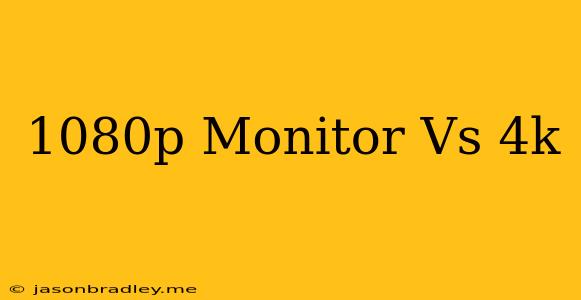1080p vs 4K Monitors: Which is Right for You?
Choosing the right monitor can be a daunting task, especially with the plethora of options available. One key decision you'll need to make is between 1080p (1920 x 1080) and 4K (3840 x 2160) resolution. Both offer distinct advantages and disadvantages, so let's dive into the key differences to help you make an informed choice.
1080p: The Classic Choice
1080p monitors have been the standard for years, offering a good balance of price, performance, and image quality.
Pros:
- Affordable: 1080p monitors are generally cheaper than 4K counterparts, making them a budget-friendly option.
- Wide Availability: You can find 1080p monitors in a wide variety of sizes and features, from basic to high-end.
- Good Performance: 1080p resolution is less demanding on your graphics card, allowing for smoother gameplay and higher frame rates in games.
- Suitable for Everyday Tasks: For tasks like browsing the web, email, and office productivity, 1080p offers a comfortable and sharp viewing experience.
Cons:
- Lower Resolution: Compared to 4K, 1080p offers a lower pixel density, leading to less detail and sharpness, especially on larger screens.
- Pixelation: At close distances, individual pixels can become noticeable, impacting the viewing experience.
4K: The Future of Display
4K monitors offer a significant jump in resolution, resulting in a significantly sharper and more immersive viewing experience.
Pros:
- Exceptional Detail: 4K displays offer four times the pixels of 1080p, resulting in significantly sharper text, images, and videos.
- Immersive Viewing: The higher resolution creates a more immersive experience for watching movies, playing games, and editing photos.
- Future-Proof: As 4K content becomes more prevalent, a 4K monitor will ensure you are ready for the future.
Cons:
- Expensive: 4K monitors are significantly more expensive than their 1080p counterparts.
- Demanding on Hardware: 4K resolution requires a powerful graphics card to deliver smooth performance in games and demanding applications.
- Limited Content Availability: While 4K content is growing, it is still not as widely available as 1080p, meaning you may have to settle for upscaled content.
Choosing the Right Monitor for You
The best choice for you depends on your specific needs and budget.
- For budget-conscious users and casual tasks: A 1080p monitor offers a good balance of price, performance, and image quality.
- For gamers, creatives, or those who value a premium viewing experience: A 4K monitor provides the best detail and immersion, but comes at a higher price and demands a powerful PC.
Ultimately, the best way to decide is to consider your budget, the tasks you intend to use the monitor for, and the size of the display.
